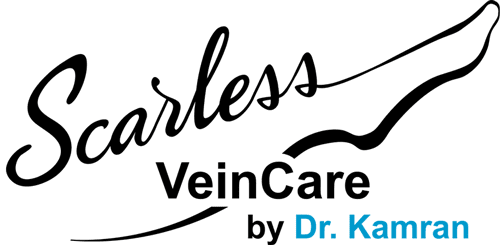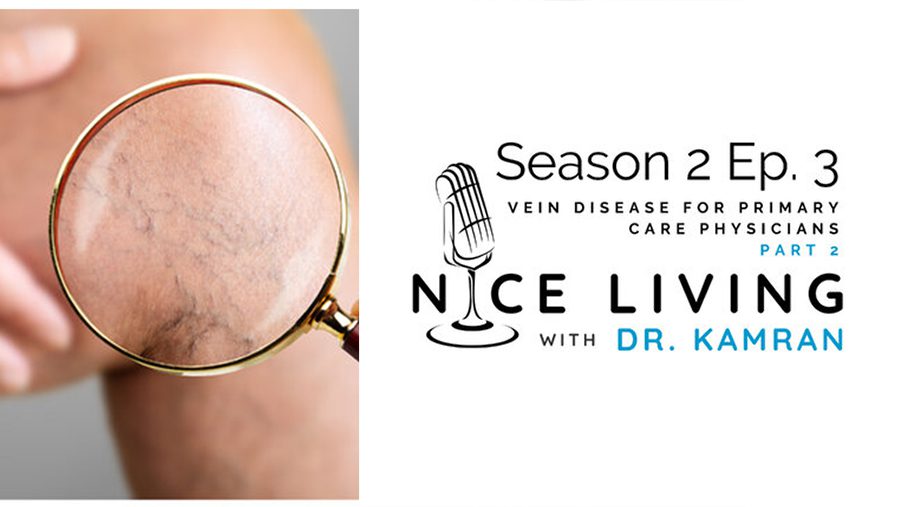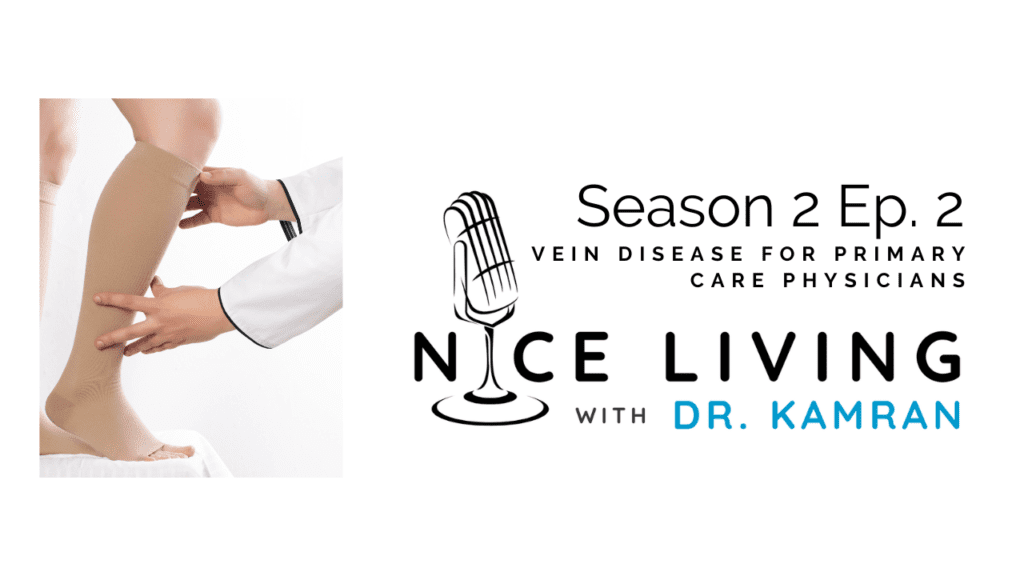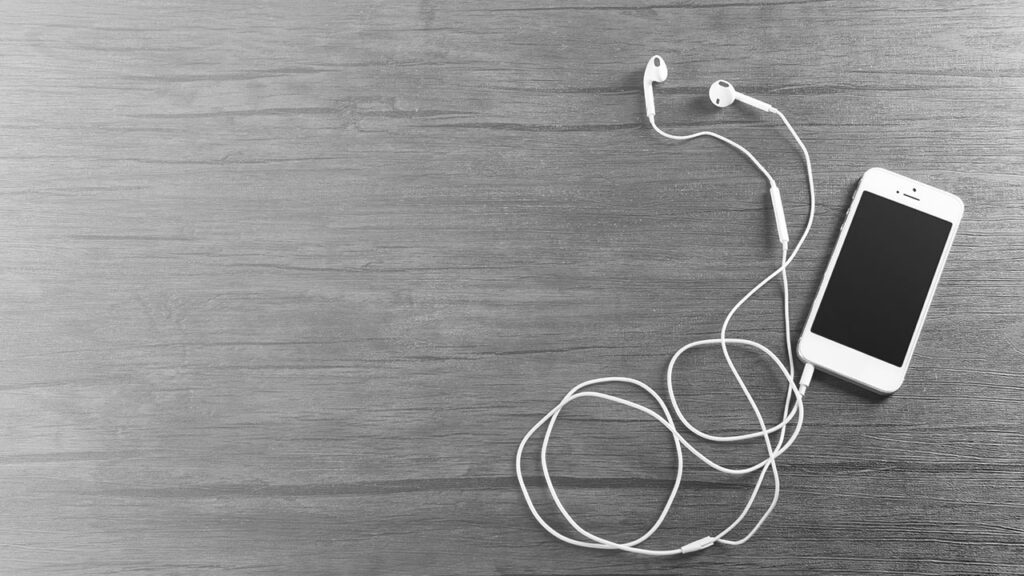Episode 2 – Vein Disease Part 1: Vascular System Overview & Risks Factors
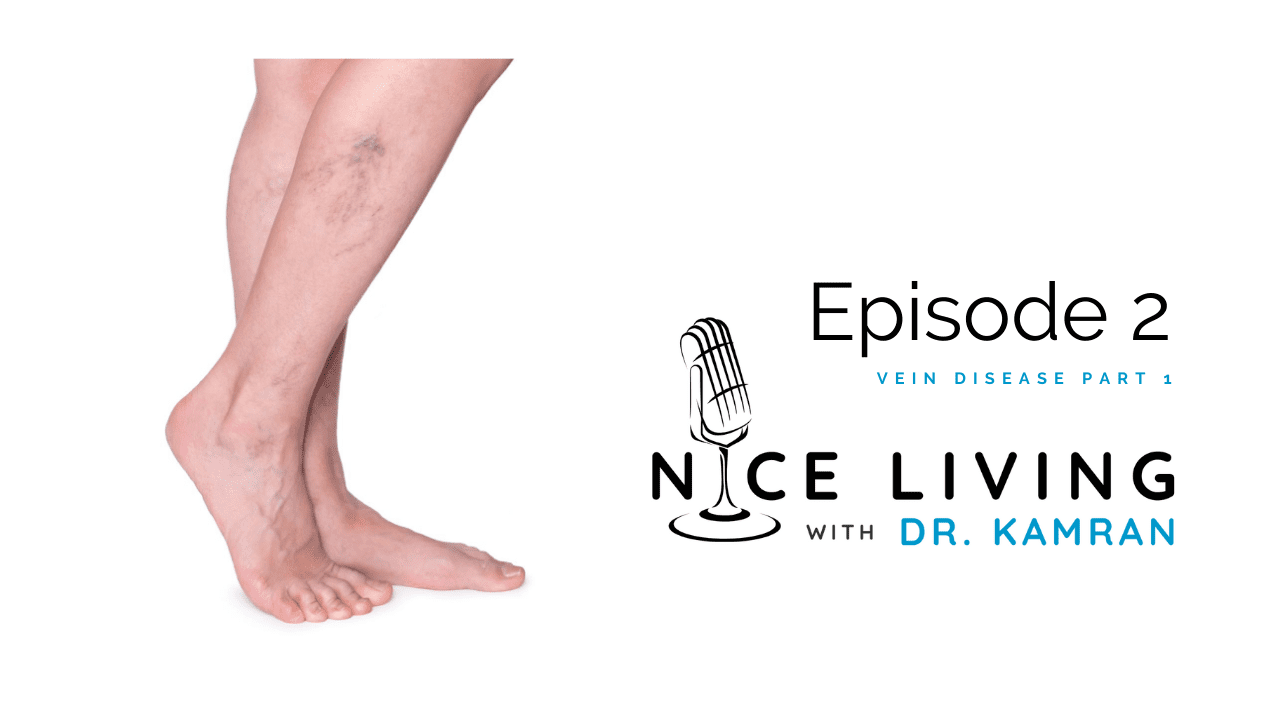
Episode Description
Disclaimer: This program discusses medical information that is general in nature, and not intended to serve as medical advice to treat any medical condition in either yourself or others. Consult your own physician for any medical issues that you may be experiencing.
While this podcast is dedicated to shedding light on many health and wellness topics, our show’s namesake and host, Dr. Kamran Goudarzi of Scarless Vein Care, is one of the foremost experts in the nation when it comes to the treatment of Varicose and Spider Veins. So, over the next few episodes we’re diving deep into venous disease.
In Part 1, Dr. Kamran gives an overview of the vascular system’s form and function and discusses how risk factors such as genetics, lifestyle and even your profession can influence your chance of developing varicose veins, spider veins and vein disease.
Find a full transcription of the podcast featuring helpful links below the podcast player.
Curious about the symptoms vein disease? When you should seek help from a vein doctor? Listen to Part 2 in this series on vein disease to hear Dr. Kamran’s expert insight and opinion.
The following program discusses his medical information that is general in nature and not intended to serve as medical advice, to treat any medical condition in either yourself or others. Consult your own physician for any medical issues that you may be experiencing.
:24 Welcome to episode #2 of Nice Living with Doctor Kamran. I’m your co-host Aimee Bowen, and while this podcast is dedicated to shedding light on many health and wellness topics, our show’s namesake and host, Doctor Kamran Goudarzi of Scarless Vein Care just happens to be one of the foremost experts in the nation, when it comes to the treatment of varicose veins and spider veins.
So, over the next couple of episodes were going to be diving deep into vein disease. Also known as venous disease. We’re going to be talking about the causes, the risk factors, symptoms and treatment options as well.
So let’s get to it. Welcome Dr. Kamran.
Thanks Aimee! Of course, we are trying to do this Nice Living with Doctor Kamran, as you mentioned, where we cover a whole series of topics, things which commonly affect people and they are very interested to know, but I thought I would start off by talking about venous disease, because I have spent very many years in general, and general vascular surgery past 17 years, really the treatment of illness, disease was revolutionized by what we call intravascular treatment and from a hospital city to outpatient setting is set up dedicated large portion of my life in treating venous disease so I felt could consider my server some whatever expert in treating venous disease. So I thought we started by talking about veins and thank you for giving me the opportunity to do this.
So to start Doctor Kamran how does the vascular system work and what actually happens structurally when things start to go wrong?
Well, we all know about circulation. Circulation doesn’t matter whether (2:00) it’s a brain or legs or in testing, its, it works with two components. The blood gets pumped to the tissue from your heart. The heart has a fair amount of pressure, it pushes the blood through to a tissue. But, then it’s gotta get out, and the venous part or the vein part is when the blood returns back to the heart. So, the way I would probably compare it to everyday life, you know, for example, here we are in Wilmington, NC, there’s this Highway I-40 which is very fast, very efficient most of the time. So 75 miles an hour, 70 miles an hour you’re driving, get to Wilmington in no time. The minute you get to the outskirts of Wilmington, there’s always some congestion, whether city planning, whatever the issue could be, and the traffic is not moving, so now the arteries is what takes you through the highway to Wilmington. Considering, if there was no issue with the traffic, but once it makes it to Wilmington, it can’t get out, so you can’t get out of Wilmington to go to Myrtle Beach or whatever else, you know, you want to go, if you were going through Wilmington, so it creates a congestion. This slows down the traffic. And venous is the same thing. So if the blood is not getting out, it causes congestion and it slows down the circulation. As I often say, circulation is not just blood getting there, is getting there and getting out. So that was basically a short version of the physiology, blood gets in the leg, but it cannot get out, so normally would get out through the veins back into the heart, or from the head back into the heart, or from your arms back to the heart through the venous system through the veins.
So you draw this comparison to a highway as far as how the flow can kind of get backed up, and I think from a really basic level of understanding, a lot of people probably think of their veins as just these pipes where the blood supply just kind of flows through. But that’s not all there is to the structure, and how veins actually work, is it?
Uh, no, no, not not really.
4:00 So I think if I was going to compare it I would say it’s more like rivers and tributaries. In fact, the branches of the vein and medical school, they always remind you they’re not branches or tributaries because it’s more like rivers and these are not pipes as you mentioned in that there are muscles inside inside the vein wall, and those muscles make the vein contract to some extent or dilate. And if the structure of the vein is damaged, if the muscle is damaged or the vein wall is damaged, then the vein becomes very thin walled, it becomes like, its just like a tire on your bike, it’s pushes out in some areas and it can even rupture. I mean that’s how veins do ruptured and sometimes they get cut, but one of the major problems with veins is when the blood gets from the heart into the tissue the blood vessels getting smaller and smaller eventually got microscopic and they get into what we called capillaries, when it gets to the capillaries now we’re talking about things that you could barely see with your microscope. The red cells find themselves out of the this road called the artery, get into what they’re supposed to be doing, which is cells to try to give the nutrition, give the oxygen, and once these cells have gotten the nutrition and oxygen, then the blood, which now doesn’t have much nutrition left and oxygen left, tries to get back into the venous system. That’s why blood in the vein is usually blue, because it does not much oxygen. Blood in the arteries are red, so by the time they come back into the veins there is no pressure, all of the pressure was taken going through all these capillaries, so the heart might have pumped it at 120 or 140 millimeters of mercury when it passes through this tiny, tiny, microscopic vessels are the pressure is gone. And now the blood is trying to get back to the heart, it can’t. So what pushes the blood back? We found that it is a series of muscles, particularly the calf muscles, which is very much responsible for getting the blood back to the heart, of course thigh muscles, even respiration can affect it, but the calf muscle seems to be the main main muscle
6:00 which pushes the blood back to the heart, and valves. So, when you want to push something out, you have to squeeze the vein, and then, as the muscles contract, like when you’re walking, you’re squeezing the vein, blood gets out, and then the muscle relaxes blood tries to get back, but there are valves inside the veins, so blood can get back out, arteries don’t have valves, they don’t need to because it’s low pressure there, veins have valves.
You know, Doctor Kamran, I think most people are familiar with valves, you know when it comes to the structure of the heart, but probably not so much when it comes to veins. So how similar are these in terms of structure and function and then what role can these valves play when it comes to vein disease?
Of course the heart valves are a lot bigger, but they function very, very similar to it. Now, the heart valves and others we know where the valves are, there are very unique and veins they’re a little bit variable. One of the most consistent veins, not just talk about the veins in the legs because that’s the main issue usually in most people who have Venous Insufficiency is the veins in the leg. There is a valve right in the groin called the saphenofemoral valve and that, but a lot of people believe that’s the first valve which gets worse. There’s some controversy there, some people believe in ascending theory in descending theory, but essentially the first valve, most people believe the first valve which gives is the saphenofemoral valve. And then after that valve there’s a preterminal valve, which means the valve before the terminal valve and these are involved in the groin. And there are several valves until you get to the knee, as you pass the knee the number of valves increase and the lower down you go, the more valves there are. So, they’re not very consistent, but they’re present all the way through the venous system. Essentially, if you think about a pump, a pump works very well, as long as, you know, you can squeeze it, and it has a valve which gets the blood out. Now, if you have valves in the heart that doesn’t work, you get heart failure. Well, when the veins in the leg, those valves get defective than the blood can’t
8:00 get out of the leg. So you get congestion, you get swelling, you get all the symptoms, a sign of venous insufficiency as we call it, like cardiac insufficiency would be venous insufficiency, just means is defective, the blood can’t get out.
So we’re finding out now that vascular issues are extremely common. I mean, in fact, there’s evidence indicating that the condition is so common it’s an estimation that had effects nearly one in eight adults in the US. Women, of course more likely to develop them or those vascular issues than men, and they’re not just cosmetic issues. Vascular issues can be quite serious. In our next episode we’re going to be talking a little bit more in depth about the signs and symptoms of vein disease, but right now, let’s talk about the risk factors. Who’s likely to face this condition Doctor Kamran?
So there’s of course all kinds of reasons for veins not to function properly. You can have clots in the deep system which might not go away and therefore block the venous system. I’m not going to bore you too much about all the things which can cause pathology, but let’s talk about the common things you’re absolutely right, anywhere from 40 to 50 percent of people have some degree of venous insufficiency. Now some people, the numbers are a little bit less than that. Some people think it is more. But overall, we know it’s a little bit more common in women than men, but there is a part of it we don’t fully understand and this part we do understand. We do understand that the valves in the legs become defective, they don’t work. And we know there’s a genetic predisposition to it. So why some people get disease of this valve and the valves don’t function, we don’t fully understand. But we know if any of your parents have it, whether mom or dad, the chances of you getting it is extremely high. As somebody said the only way to avoid it is next time, have a different set of parents, so, so genetic predisposition. I’ve done literally thousands and thousands of vein procedures,
10:00 and I’ve seen at least 100 times more than I’ve done vein procedure. So, the common denominator seems to be genetics, all these patients seem to have somebody in the family who has venous disease. So why does the valve stop functioning in these people, we don’t know, and we found out that it happens in the legs and not in their arms.
So as we mentioned, women or more likely to encounter vein disease than men. Can you talk a little bit more about why this may be the case?
More recently studies I was reading some very few years ago where they measured what we got estrogen receptors in the veins of the leg and they were a lot more of these receptors in the veins of the legs then there are anywhere else. So there’s something unique about veins in the leg. So if there are estrogen receptors we know anything which increase your estrogen level is going to also cause your veins to get worse, so for example, during ovulation, when estrogen level is is elevated and therefore their veins start getting more dilated and I have a lot of patients who have venous insufficiency tell me that they really start, their legs are really aching around their period, and because of high estrogen level. Or during pregnancy for example, we used to think it was the weight of the uterus because you gain weight during pregnancy or weight of the baby pushing on the on the blood vessels and veins in the pelvis, now we found out they estrogen itself is very important in making your venous disease worse. So one of the recommendations is start wearing compression stockings. The minute the urine turns positive and don’t wait till you’re showing, you know, that you’re pregnant by that time is a little late. So I strongly recommend anybody gets pregnant, you know, wearing compression stocking and will slow the disease down, it might not stop it but it will definitely slow it down. So these are just of course hormonal factors, pregnancy is very unique because you got the whole hormonal factor, then you got their weight gain, you know, salt retention. You got a weight of the uterus pushing on the venae cavae and the leg veins which actually
12:00 drain, drain the veins from the leg. So if the blood can get out, it backs up and can tear those valves, but there are other things which contribute to one getting venous disease. I’ve added to this list a tall men, because tall men are rather unique men usually have much larger veins than women, so imagine you’ve got this gigantic veins on your legs and I’m sure you’ve all seen guys with this ropy like snakes on their legs, which are waste, you know, dilated veins. So because they’re tall, the heart is a lot higher than the foot than an average person. So you can imagine the hydrostatic pressure at the ankle is very high, and if one of those veins ever ruptures, they have massive bleeding and you have so much blood pooling in the leg that is just tears a lot of those valves, and sometimes I’ve heard them say that they get light headed or feel weak after a while and will sit down and keep the leg elevated, although it hasn’t been shown scientifically anywhere that I’ve read. But common sense tells me, if all these large veins in your leg are getting full of blood and blood is not returning to your heart, then you’re probably down maybe a pint or two, or maybe more, where the blood and stuff coming back to your heart is sitting in your legs, so clearly your cardiac output, your energy level,everything gets affected by that. So I think tall people because of hydrostatic pressure in large veins also are very prone to getting it, especially with a genetic predisposition.
OK, so those are the genetic components, but lifestyle and even what you do for a living can play a role in vein disease too, right?
Absolutely! So let’s talk about some of the jobs. Jobs which involve sitting for a long period of time. For example, if you’re in accounting, secretary or a truck driver, I’ve had all of these patients I’ve had accountants who particularly around during the tax time when they’re most accountants tell me, you know, when it’s a tax period, they are really overworked, they’re sitting for hours and hours trying to take care of everyone’s’
14:00 tax issues and filing the tax returns. And usually their legs are the worst then because they’re sitting there hardly get a chance to get up and walk. So for long sitting, you know that, that is one. I remember a lady who used to just record things in court. She had done it for 25 years. She spent most of the time sitting there just typing all day. I don’t know how many hours, but you know quite a few hours and she had very bad venous disease and had very advanced skin changes because of venous disease. Truck drivers, I’m amazed, you know, I’ve had quite a few truck drivers with truck drivers are tough, they say “oh, my leg hurts because you know I’m constantly driving.” No, in fact what we are finding out, if your problem is related to your veins, where some compression stockings and find that your legs don’t hurt as much, then it is venous insufficiency, you’re sitting in the truck driving hours and hours blood is just pooling in the leg can get out. Like I see those sometimes with an ultrasound and when I’m looking you can clearly see when the calf muscles don’t move the blood just sits there in the in the leg. It just doesn’t get out. And of course the longer stays the more oxygen is extracted from it. So the more you get lactic acid formation, more achy, more heaviness, more tiredness. It’s almost like somebody put a tourniquet on their groin and not take it off and just don’t cut the arteries but just the veins, and then just don’t take it off till they come home and elevate their legs. So if somebody put a tourniquet on your arm and they were going to draw your blood but he forgot to take the tourniquet off you find out eight hours later if your hand is blueish, sore, achy, heavy tired. These people had this very similar symptoms so that in their legs. So, truck drivers important. Now also jobs which involve standing, now walking and running is the best thing you can do for veins. But if you’re standing in the same position, of course I’m a surgeon, sometimes I was 12/14 hours in the same operation standing up in one position. Well surgeons are prone to getting venous sufficiency. Nurses, they are standing for long periods of time. Whether they are in the ICU or recovery room, wherever they are, they’re on their feet. Real Estate agents, you know, I know,
16:00 they’re either driving or getting up and talking to the clients. Attorneys are standing in court or sitting for hours. Pilots are very unique situation, because one of the pilots told me that the majority of times the planes are not really pressurized. So as soon as you get into a plane and it is obviously not pressurized, have to get above a certain level before its pressurized. So I’ve noticed the vast majority of pilots I’ve met you can almost guarantee they’ve got venous insufficiency unfortunately. So do they flight attendants because they are in the plane in a long period of time so they get venous insufficiency. Retail workers you know, similar kind of situation.
So is it accurate to say that vein disease most commonly affects the legs?
There seems to be something unique about veins in the legs that are more prone to becoming defective. So what makes them defective is the valves and once the valves are going like any other, pump your calf muscle and your veins and the valves are part of a pump system the pump can fail because you’re not using your calf muscle or because a vein is stretched, or disease or traumatized. Or most likely, the most common one is the valves quit functioning. They get stretched, and then I call it the domino effect when the first valve gives in the groin, then there’s a lot more weight of blood on the second valve and of course the second valve like a dam breaks down and then more flooding in the third valve. And you know the show goes on and it kind of reminds me, when was it, during the hurricane I think was in New Orleans, I was watching one of the dams which broke and you could see the water was going down it was breaking more and more dams as it went through. And valves work the same way, once the first one gives there’s more pressure in the second and third and 4th.
And building momentum.
Yeah, absolutely. I’ve had patients come in and say, “Doc, you know I’ve always had varicose veins, but it’s just over the last month I’ve developed two more and then I’m developing a lot more. So what’s going on?” And that’s exactly what’s going on. Once the disease is started it’s almost like a zipper on your jacket, once it starts tearing down it just keeps on going.
18:00 Well, Doctor Kamran, I know we’ve just barely scratched the surface when it comes to vein disease.We’ve got lots more to talk about. Thanks so much for all the insight you shared with us today. Did you have any final thoughts for the listeners?
So, they say an ounce of prevention is better than a ton of cure. If you think you got venous disease, just go ahead and find a doctor in your vicinity and let them look at it and we’re going to talk about that, Aimee, as you know later on about, “ where do you go if you have venous disease, you know, what kind of doctor do you ask for help.” But you know we cover that in our next episode?
That’s right, this is just one episode in our series on vein disease.
So, in our next episode we’re going to be talking more about the specific symptoms. How do you know if you have vein disease? When should you go see a doctor? What are the treatment options? And then, of course, what can you expect before, during and after treatment as well?
Thank you so much for listening to the show. This is the Nice Living with Dr. Kamran Podcast. We invite you to subscribe to the show on your favorite platforms so you can find out as soon as new episodes publish. You can learn more about the show at scarlessveincare.com/podcast.
19:03 That’s where you can also view the notes for this episode. You can find relevant links to topics we’ve discussed, and you can even recommend topics for upcoming shows. So of course, Dr. Kamran is by all accounts a vascular expert, but the show’s not exclusively focusing on vein related topics. So from back pain to gallbladder issues, anything in between Dr. Kamran has broad experience as a general surgeon and of course, many fellow physician friends who we’re going to be featuring on the show soon. And they are ready to provide the insight on health topics that matter to you.
Again, that’s scarlessveincare.com/podcast to send us that email with topic recommendations. Until next time I’m Aimee Bowen.
And I’m Doctor Kamran.
Wish you the best of Health, Happiness and Nice Living in the meantime.
Thanks for listening!
Thanks so much for listening to our podcast! If you enjoyed this episode and think that others could benefit from listening, please share it using the social media buttons on this page.
Have questions about this episode or want to recommend a topic for Dr. Kamran? Email us: NiceLivingPodcast@gmail.com
Subscribe to the podcast
Get automatic alerts for new episodes by subscribing to the podcast on your favorite platform.
Leave us an iTunes review
Ratings and reviews from our listeners are greatly appreciated! They help our podcast rank higher on iTunes and others discover the important information we're sharing. If you have a minute, please leave an honest review on iTunes.
